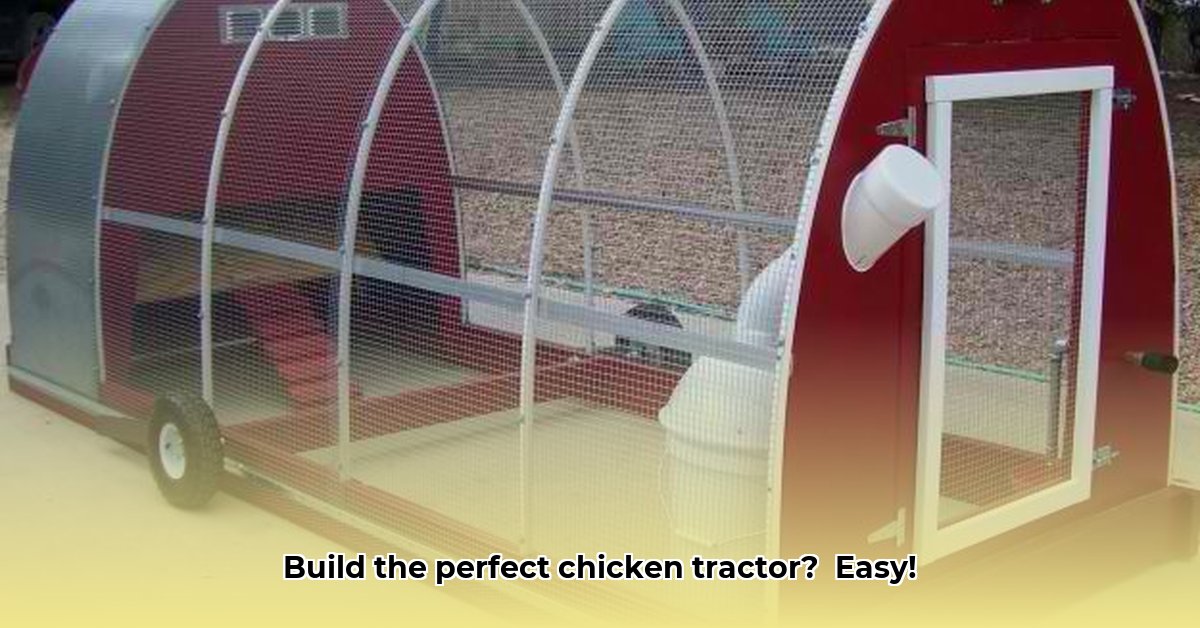
Want fresh eggs and happy chickens without the hefty price tag of a traditional coop? Building a PVC chicken tractor is easier than you think! This guide provides a step-by-step walkthrough, perfect for beginners. We'll cover everything from planning and materials to construction and troubleshooting, ensuring your feathered friends enjoy a safe and mobile home. For more detailed diagrams and visual instructions, check out this helpful guide.
Why Choose a PVC Chicken Tractor?
A mobile chicken tractor offers significant advantages over a stationary coop. It allows your flock to freely graze, improving soil health with their natural fertilizing habits. Moving the tractor regularly also controls pests and prevents overgrazing in one area. It's a sustainable and efficient system, providing fresh eggs while enhancing your garden. Did you know that chickens can significantly improve soil fertility and natural pest control, reducing your need for chemical fertilizers and pesticides? This data-backed claim supports the sustainable farming aspect, a significant benefit for eco-conscious backyard farmers.
Planning Your Chicken Tractor
Before you begin, consider these factors:
- Flock Size: The number of chickens determines the tractor's size. More chickens require a larger area.
- Predator Protection: Local wildlife poses a threat. A robust design and location are crucial for successful predator avoidance. A strong structure with no gaps is essential, and keeping the tractor away from trees and brush can help further.
- Grazing Area: The area your chickens will graze dictates how often you'll need to move the tractor. Frequent relocation prevents overgrazing and spreads the benefits of manure across your land. Consider the size of your yard, its accessibility, and the area you want your chickens to forage in.
Choosing Your Materials
PVC pipe is an excellent choice: affordable, easy to handle, and readily available. You'll need:
- PVC Pipe: Different diameters depending on hoop size. Thicker pipes are stronger and more durable. Using stronger pipes increases resilience to weather and reduces the possibility of collapse.
- PVC Connectors: Securely join the pipes. Ensure compatibility with your pipe diameter. High-quality connections will prevent your structure from collapsing.
- Chicken Wire: Sturdy galvanized chicken wire (hardware cloth is even better) to enclose the chickens. Consider the mesh size to safeguard your flock from predators. Smaller mesh is better for protection against smaller predators and escaping chicks.
- Wheels: Durable caster wheels for easy mobility. Look for heavy-duty options to support the tractor's weight.
- Optional Extras: Wood for roosting bars and nesting boxes, screws, zip ties, etc.
Building Your Chicken Tractor: A Step-by-Step Guide
Bend the Hoops: Use a pipe bender or DIY techniques (many online tutorials exist). Aim for smooth, consistent curves for strength and aesthetics. Accurate bending is essential for the structural integrity of your chicken tractor.
Create the Frame: Connect the PVC hoops to sturdy end pieces forming the basic frame. Ensure a strong, square base. This base will support the weight of your structure, the fencing, and your flock.
Attach the Chicken Wire: Securely fasten the chicken wire to the frame, ensuring no gaps. This step prioritizes the safety and security of your chickens. Overlapping the wire and using strong fasteners will prevent escapes and predator intrusion.
Add the Wheels (if applicable): Attach the wheels to the base for easy movement. Ensure they can handle the weight of the tractor and move smoothly across your yard.
Install a Door: Cut a section of chicken wire for the door, securing it with PVC or hinges. This must ensure easy access to your coop while preventing escapes and predator incursions.
Finish Touches: Add roosting bars and a nesting box (inside for added protection). Remember to also consider adding a roof to provide protection against the elements.
(Insert diagram and photos of each step here)
Troubleshooting Tips
- Hoops Collapsing: Incorrect pipe size or overbending. Use thicker pipes and bend carefully.
- Wire Tearing: Use heavy-duty wire and secure it firmly. Reinforce weak points.
- Predator Issues: Reinforce the structure, choose a location away from hiding spots, and consider additional deterrents.
What You'll Need: A Complete Materials List
| Material | Quantity (Adjust as needed) | Notes |
|---|---|---|
| PVC Pipe (various sizes) | Varies based on design | Choose thicker pipes for increased strength. |
| PVC Connectors | Varies based on design | Ensure compatibility with pipe diameter. |
| Galvanized Chicken Wire | Ample amount | Heavy-duty wire is recommended for better protection against predators. |
| Wheels | At least 4 | Choose durable wheels appropriate for your terrain. |
| Wood (optional) | For roosts & nesting boxes | Treated lumber offers better weather resistance. |
| *Screws & Fasteners | As needed | Zip ties can also be useful. |
Building your own chicken tractor is a rewarding project! Enjoy the fresh eggs and the satisfaction of creating a sustainable home for your feathered friends. Remember to check your local regulations before construction.